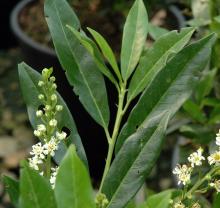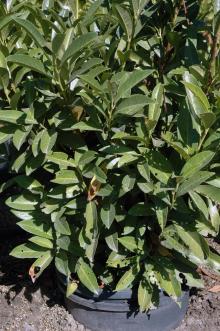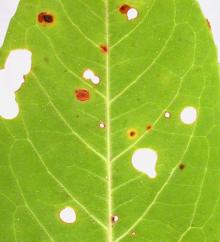See:
Peach (Prunus persica) - Shothole
Cause Shothole symptoms are commonly observed on Prunus spp. and can be caused by a variety of factors. Development of the shothole symptom is in response to mechanical, chemical, or pathogen injury. There is the formation of meristematic tissue around the injury that becomes lignified or suberized to form a physical and biochemical barrier that, in the case of pathogens, limits the colonization of healthy tissue. The formation of an abscission layer may be dependent on temperature. In almond leaves, an abscission layer formed at 72°F but not at 59°F.
The bacteria Pseudomonas syringae pv. syringae and Xanthomonas arboricola pv. pruni as well as several fungi including Cercospora sp., Blumeriella sp., and Wilsonomyces carpophilus (Coryneum blight) can cause leaf spots and shothole on cherry laurel (English laurel, Otto Luyken, or 'Zabeliana'). Several other fungi and bacteria have been found to cause shothole symptoms. Of particular concern is the oomycete Phytophthora ramorum, which is a regulated organism.
Copper spray injury and boron toxicity can also cause leaf spotting and shothole. When symptoms are advanced, it is not possible to identify the cause specifically. Some virus infections (such as prunus necrotic ringspot virus) can cause a shothole symptom in fruiting cherries but this has not been reported for cherry laurels.
Cherry laurels (English laurel, Otto Luyken, or 'Zabeliana'), P. laurocerasus and sometimes other Prunus spp. including cherry and plum, commonly show shothole symptoms resulting from only cultural or environmental stress. Both container- and field-grown laurel can develop symptoms. Some growers have observed that plants are more susceptible to symptom development when grown in containers. Portuguese cherry laurel (Prunus lusitanica) is nearly resistant.
Symptoms Necrotic leaf spots with circular to irregular margins. Bacterial spots are brown surrounded by a reddish border with a yellow halo. Abscission layers develop around necrotic leaf spots causing the injured tissue to drop away, leaving holes and tattered areas in the leaf (as if someone fired a shotgun at the leaf-thus the name shothole). After tissues drop, most often it is difficult to determine specifically what caused the initial injury. Observations of early symptom development, signs, and symptoms on other areas of the plant may help make an accurate diagnosis.
Cultural control No management practices have been shown to help reduce physiological shothole. For disease-induced shothole, try the following.
- Avoid overhead irrigation or apply such that plants are not wet for extended periods of time.
- Remove and destroy fallen leaves.
- Do not plant near other flowering or fruiting Prunus spp.
- One nursery reported good success with first growing in the field and then potting plants the year before sale rather than starting with containers.
- The cultivar Chestnut Hill is reported to have superior resistance to shothole when compared with Otto Luyken.
Chemical control Use only if a bacterial or fungal cause has been identified.
- Cinnerate at 16 to 64 fl oz/100 gal water plus an adjuvant. No reentry listed. O
- Daconil Weather Stik at 1.38 pints/100 gal water is registered for fungal leaf spots. Group M5 fungicide. 12-hr reentry.
- Fixed coppers may help against both fungi and bacteria but can cause leaf injury and defoliation. Group M1 fungicides. 48-hr reentry. O
- Heritage at 1 to 4 oz/100 gal water plus a non-silicone-based wetter sticker for fungal problems. Group 11 fungicide. 4-hr reentry.
- Junction at 1.5 to 3.5 lb/A. Can be more effective than other copper-based products when copper-resistant bacteria are present. Spray solution pH should be above 6.5. Group M1 + M3 fungicide. 48-hr reentry.
- Protect DF at 1 to 2 lb/100 gal water plus 2 to 4 oz spreader-sticker. Mancozeb-based products were found useful for both fungal and bacterial causes. Group M3 fungicides. 24-hr reentry.
- Spectro 90 WDG at 1 to 2 lb/100 gal water. For fungal problems. Group 1 + M5 fungicide. 12-hr reentry.
References Adaskaveg, J.E. 1995. Conidial morphology, host colonization, and development of shot hole of almond caused by Wilsonomyces carpophilus. Canadian Journal of Botany 73:432-444.
De Boer, S.H. 1980. Leaf spot of cherry laurel caused by Pseudomonas syringae. Canadian Journal of Plant Pathology 2:235-238.





